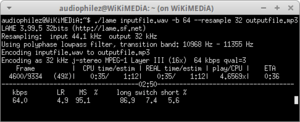LAME
 LAME official logo | |
|
LAME v3.99.5 running under Linux | |
| Developer(s) | The LAME development team |
|---|---|
| Initial release | 1998 |
| Stable release |
3.99.5
/ 28 February 2012 |
| Operating system | Cross-platform |
| Type | Codec |
| License | GNU Lesser General Public License |
| Website |
lame |
LAME is an encoder that converts audio to the MP3 file format. LAME is a free software project that has had many improvements since it was first released in 1998, including an improved psychoacoustic model. Lame is widely recommended as an MP3 encoder, because it performs well in codec listening tests.[1] The LAME encoder outperforms early encoders like L3enc.[2]
LAME is required by some programs (e.g., Audacity) to create MP3 files. LAME is required as an add-on for many Open Source audio programs because the MP3 format is encumbered by software patents. Having these patented procedures (which require licensing in some countries) moved to a separate program allows Open Source programmers to avoid having to worry about those copyright issues.
History
The name LAME is a recursive acronym for "LAME Ain't an MP3 Encoder".[3] Around mid-1998, Mike Cheng created LAME 1.0 as a set of modifications against the "8Hz-MP3" encoder source code. After some quality concerns raised by others, he decided to start again from scratch based on the "dist10" MPEG reference software sources. His goal was only to speed up the dist10 sources, and leave its quality untouched. That branch (a patch against the reference sources) became Lame 2.0. The project quickly became a team project. Mike Cheng eventually left leadership and started working on tooLAME (an MP2 encoder).
Mark Taylor then started pursuing increased quality in addition to better speed, and released version 3.0 featuring gpsycho, a new psychoacoustic model he developed.
A few key improvements, in chronological order:
- May 1999: a new psychoacoustic model (gpsycho) is released along with LAME 3.0.
- June 1999: The first variable bitrate implementation is released. Soon after this, LAME also became able to target lower sampling frequencies from MPEG-2.
- November 1999: LAME switches from a GPL license to an LGPL license, which allows using it with closed-source applications.
- May 2000: the last pieces of the original ISO demonstration code are removed. LAME is not a patch anymore, but a full encoder.
- December 2003: substantial improvement to default settings, along with improved speed. LAME no longer requires user to use complicated parameters to produce good results.
- May 2007: default variable bitrate encoding speed is vastly improved.
Patents and legal issues
Like all MP3 encoders, LAME implements some technology covered by patents owned by the Fraunhofer Society and other entities.[4] The developers of LAME do not themselves license the technology described by these patents. Distributing compiled binaries of LAME, its libraries, or programs that derive from LAME in countries that recognize those patents may be patent infringing. Most or all of these patents are now expired.
The LAME developers state that, since their code is only released in source code form, it should only be considered as an educational description of an MP3 encoder, and thus does not infringe any patent by itself when released as source code only. At the same time, they advise users to obtain a patent license for any relevant technologies that LAME may implement before including a compiled version of the encoder in a product.[5] Some software is released using this strategy: companies use the LAME library, but obtain patent licenses.
In November 2005, there were reports that the Extended Copy Protection rootkit included on some Sony Compact Discs included portions of the LAME library without complying with the terms of the LGPL.[6][7][8]
See also
References
- ↑ "LAME". hydrogenaud.io knowledgebase.
- ↑ "Opus FAQ".
This is what made it possible for modern MP3 encoders (e.g. LAME) to improve far beyond the original L3enc and dist10 reference implementations.
- ↑ "LAME MP3 Encoder :: About". Lame.sourceforge.net. Retrieved 2012-03-17.
- ↑ "Home". mp3licensing.com. Retrieved 2012-03-17.
- ↑ http://lame.sourceforge.net/tech-FAQ.txt
- ↑ Reuters (21 November 2005). "Sony BMG Software May Contain Open-Source Code". foxnews.com. Retrieved 2011-11-26.
- ↑ "Is Sony in violation of the LGPL?". The-interweb.com. Retrieved 2012-03-17.
- ↑ "Sony's XCP DRM".
External links
- Official website
- LAME binaries - RareWares
- LAME binaries for Audacity - recommended for the Audacity free and GPL audio editor
- LAME Wiki - HydrogenAudio
- LAME Mp3 Info Tag revision 1 Specifications
